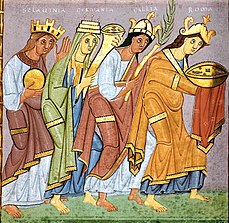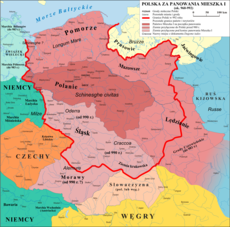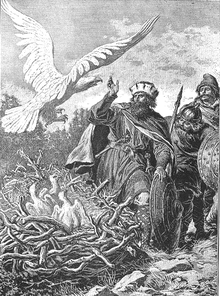Lechites


Lechites (Polish: Lechici)[1] is a term used first in the Lech, Czech and Rus fable written in the second half of the 13th century in the Kronika Wielkopolska. It then became popular to lump together ethnic and linguistic groups of West Slavs, as the ancestors of modern Poles and the historical Pomeranians and Polabians.[2][3]
History
When Mieszko I (also Dagome) inherited the ducal throne from his father he probably ruled over two-thirds of the territory inhabited by eastern Lechite tribes. He united the Lechites east of the Oder (Polans, Masovians, Pomeranians, Vistulans, Silesians) united into a single country: Poland. His son, Bolesław the Brave, with the assistance of Saint Adalbert, eradicated heathenism, and founded the bishoprics at Wrocław, Colberg, and Cracow, and an archbishopric at Gniezno. Bolesław carried out successful wars against Bohemia, Moravia, Kievan Rus and Lusatia, and forced the western Pomeranians to pay Poland a tribute. Shortly before his death Boleslav became the first King of Poland 1024.
Lechitic group
- Obodrites/Abodrites (†)
- Veleti (Wilzi)e (†)
Lechitic languages
The western Slavs included the ancestors of the peoples know later Poles, Pomeranians, Czechs, Slovaks and Polabians. The northern so-called Lechitic group includes, along with Polish, the dead Polabian and Pomeranian languages. The languages of the southern part of the Polabian area, preserved as relics today in Upper and Lower Lusatia, occupy a place between the Lechitic and Checho-Slovak groups.[4]


The name Laesir/Lech
The name Lech or Leszek, Lestko, Leszko, Lestek, and Lechosław is very popular name in Poland. Lech was popular male name among members of Piast dynasty like Lestko, Leszek I the White, Leszek II the Black, Leszek, Duke of Masovia, Leszek of Racibórz. The oldest part of Gniezno located in the center of Great Poland is known as "Wzgórze Lecha" (eng. "Lech`s Hill"), also known as "Góra Królewska" (ang."Royal Hill"). A variant of this legend, involving only two brothers Lech and Čech, is also known in the Czech Republic. Legend was described by "Kronika wielkopolska" (ang. "Greater Poland Chronicle")[5] written in 1273 in latin and Chronicle of Dalimil written in Czech language in 1314.[6] Lestko (also Lestek, Leszek) noted in the Gesta principum Polonorum[7][8][9] completed between 1112 and 1118 by Gallus Anonymus is the second legendary duke of Poland, and son of Siemowit, born ca. 870–880. Res gestae saxonicae sive annalium libri tres chronicle of 10th century Germany written by Widukind of Corvey noted that Mieszko I son of Siemomysł and grandchild of Lestek ruled over the tribe called the Licicaviki[10] that lived in what is now Poland were known as "Lestkowici" - tribe of Lestek identificated with some historians with Lendians (=Lechites).
Names Lechitae (Lechites), lechiticus (lechitic) and Lechia to describe of all medieval Poland was used many times by Wincenty Kadłubek in Chronica seu originale regum et principum Poloniae (Chronicles of the Kings and Princes of Poland) wroted between 1190–1208.[11][12] "Greater Poland Chronicle" 1273 described Casimir I the Restorer as "king of Poles means Lechites".[13] Both Poles and Lechites was used in medieval Poland as adequate terms. "Laesir is the Old Norse term for the Ljachar, a people near the Vistula in Poland".[14] Different forms of the name Lechia to describe Polish state is still present in several European languages and some languages of Central Asia and the Middle East "Lenkija" in the Lithuanian language, "Lengyelország" in the Hungarian language, "Lehia" in the Romanian language, "Lahestân/لهستان" in Persian (and via borrowing from Persian: "Lehastan" in the Armenian language, and "Lehistan" in the Ottoman Turkish language).
Sources
| Sources mentioning Lendians: Bavarian Geographer (843) – Lendizi – (33) on the map, |
Fragment of a Saga "...Tryggvi ok Tvívívill höfðu komit 12 skipum: Læsir hafði skeið ok alla skipaða með köppum " trans. Laesir, they have arrived on the large, and long-ship ... [15]
Fragment of a Saga [...] "Tryggvi and Tvivivil had brought twelve ships. Laesir had a warship full of champions. Eirik Helsing had a large dragon-ship, well manned with warriors. There were also men who’d come to King Hring from Telemark, who were champions and who had the least favour because they were considered drawlers and slow speakers. These came thence: Thorkel the Stubborn, Thorleif the Goth, Hadd the Hard, Grettir the Crooked, Hroald Toe. Also with King Hring was a man called Rognvald the Tall, or Rognvald Fist, the finest of champions. He was furthest forward in the front of the wedge, and next to him were Tryggvi and Laesir. And on the outside, Yngvi and the sons of Alrek. Then there were the men of Telemark, who everyone least wanted to have, and they thought there’d be little help to be had from them. They were great bowmen." [16]
In Latin historiography the Bavarian Geographer (generally dated to the mid-9th century) attests that Lendizi habent civitates XCVIII, that is, that the "Lendizi" had 98 gords, or settlements.
According to the Primary Chronicle entry for 981, by Nestor reports that: "Vladimir marched upon the Lyakhs (k Lyakbotri) and took their cities: Peremyshl (modern Przemyśl), Cherven (modern Czermno), and other towns "

Legends
In Polish literature Lech was also the name of the legendary founder of Poland -Lech. Legend describe of three brothers – Lech, Čech, and Rus – who founded three Slavic nations: Poland (also known as Lechia), Bohemia (Čechy, now known as the Czech Republic), and Rus (Ruthenia) - Russia, Ukraine and Belarus. In this legend Lech was the founder of Gniezno.
Three brothers Lech, Czech and Rus were exploring the wilderness to find a place to settle. Suddenly they saw a hill with an old oak and an eagle on top. Lech said: this white eagle I will adopt as an emblem of my people, and around this oak I will build my stronghold, and because of the eagle nest (Polish: gniazdo) I will call it Gniezdno (modern: Gniezno). The other brothers went further on to find a place for their people. Czech went to the South (to found the Czech Lands) and Rus went to the East (to create Russia).[13]
See also
References
- ^ Tadeusz Lehr-Spławiński. Język polski. 1978
- ^ "Laesir is the Old Norse term for the Ljachar, a people near the Vistula in Poland". [in:] Theodore Murdock Andersson, Kari Ellen Gade Morkinskinna : The Earliest Icelandic Chronicle of the Norwegian Kings (1030–1157). ISBN13 9780801436949 p. 471; "The word here for Poles is "Laesum" – the dative plural from a nominative plural "Laesir". This clearly is derived from the old name for Pole – "Lyakh", since in the course of the Slavonic paradigm -kh- becomes -s-in accordance with the "second palatalization" and the addition of the regular Norse plural ending of -ir- [...] [in:] The Ukrainian review. 1963. p. 70; "eastern Wends, meaning obviously the Vjatyci/Radimici, Laesir "Poles" or "Western Slavs" (ef. Old Rus'ian ljaxy) [in:] Omeljan Pritsak. Old Scandinavian sources other than the sagas. 1981. p. 300
- ^ "Vandalis, Gothis, Longobardis, Rugis et Gepidis, quos vacant aliqui Cimbros, quos hodie vocamus Pomeranos" [in:] Jan Długosz. Annales seu cronicae incliti Regni Poloniae. t. I., p. 35
- ^ Bohemia and Poland. Chapter 20.pp 512-513. [in:] Timothy Reuter. The New Cambridge Medieval History: c. 900-c.1024. 2000
- ^ Brygida Kürbisówna, "Studia nad Kroniką wielkopolską", Poznańskie Towarzystwo Przyjaciół Nauk, Poznań 1952
- ^ Die alttschechische Reimchronik des sogenannten Dalimil, München : Sagner, 1981
- ^ Knoll & Schaer (eds.), Gesta Principum Polonorum: The Deeds of the Princes of the Poles, (Budapest, 2003
- ^ Ljudmila Mikhailovna Popova (ed.), Gall Anonim, Khronika u Deianiia Kniazei ili Pravitelei Polskikh, (Moscow, 1961
- ^ Laurence Mizler de Kolof (ed.), Historiarum Poloniae et Magni Ducatus Lithuaniae Scriptorum Quotquot Ab Initio Reipublicae Polonae Ad Nostra Usque Temporar Extant Omnium Collectio Magna, (Warsaw, 1769
- ^ Wood, Raymond F. (tr.). "The three books of the deeds of the Saxons, by Widukind of Corvey, translated with introduction, notes, and bibliography." Dissertation. University of California, Los Angeles, 1949. English translation
- ^ Text of "Chronica seu originale regum et principum Poloniae" in Latin
- ^ "Monumenta Poloniae historica" T. 2 red. August Bielowski, Lwów 1872
- ^ a b "Kronika wielkopolska", (ang. "Greater Poland Chronicle") Kazimierz Abgarowicz, Brygida Kürbisówna, PWN, Warszawa 1965, second edition Kraków 2010, ISBN 97883-242-1275-0
- ^ Theodore Murdock Andersson, Kari Ellen Gade Morkinskinna : The Earliest Icelandic Chronicle of the Norwegian Kings (1030-1157). ISBN13 9780801436949 p. 471
- ^ Kwartalnik historyczny, Instytut Historii. Polska Akademia Nauk. t. 108, edition 1-3. 2001, p. 18, op. cit. Sagubrod, p. 64
- ^ [Fragment of a Saga about Certain Early Kings in Denmark and Sweden. Peter Tunstall, 2008] [1]
